Charles E W Bean, Diaries, AWM38 3DRL 606/251/1 - 1915 - 1936 - Part 25
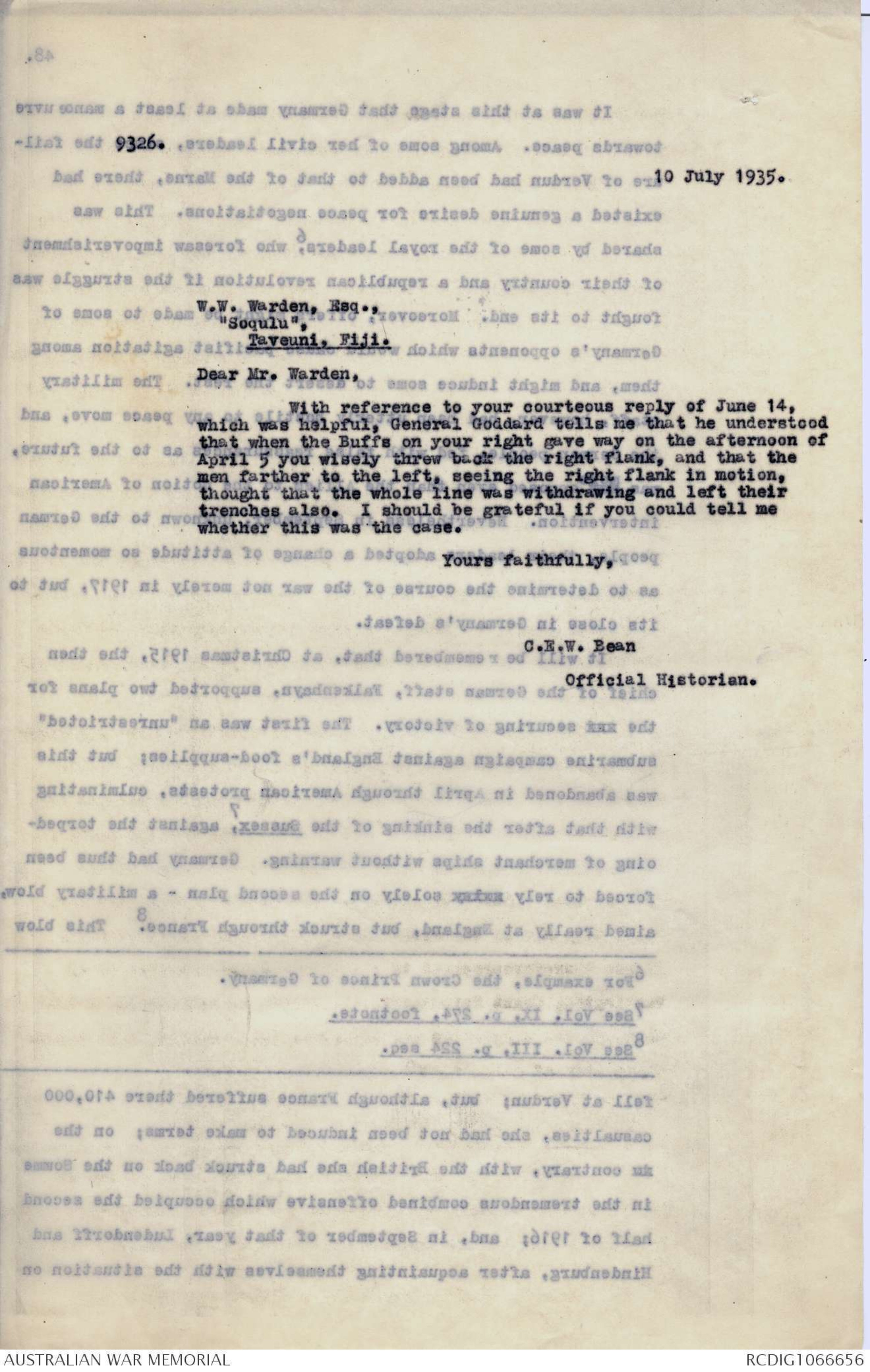
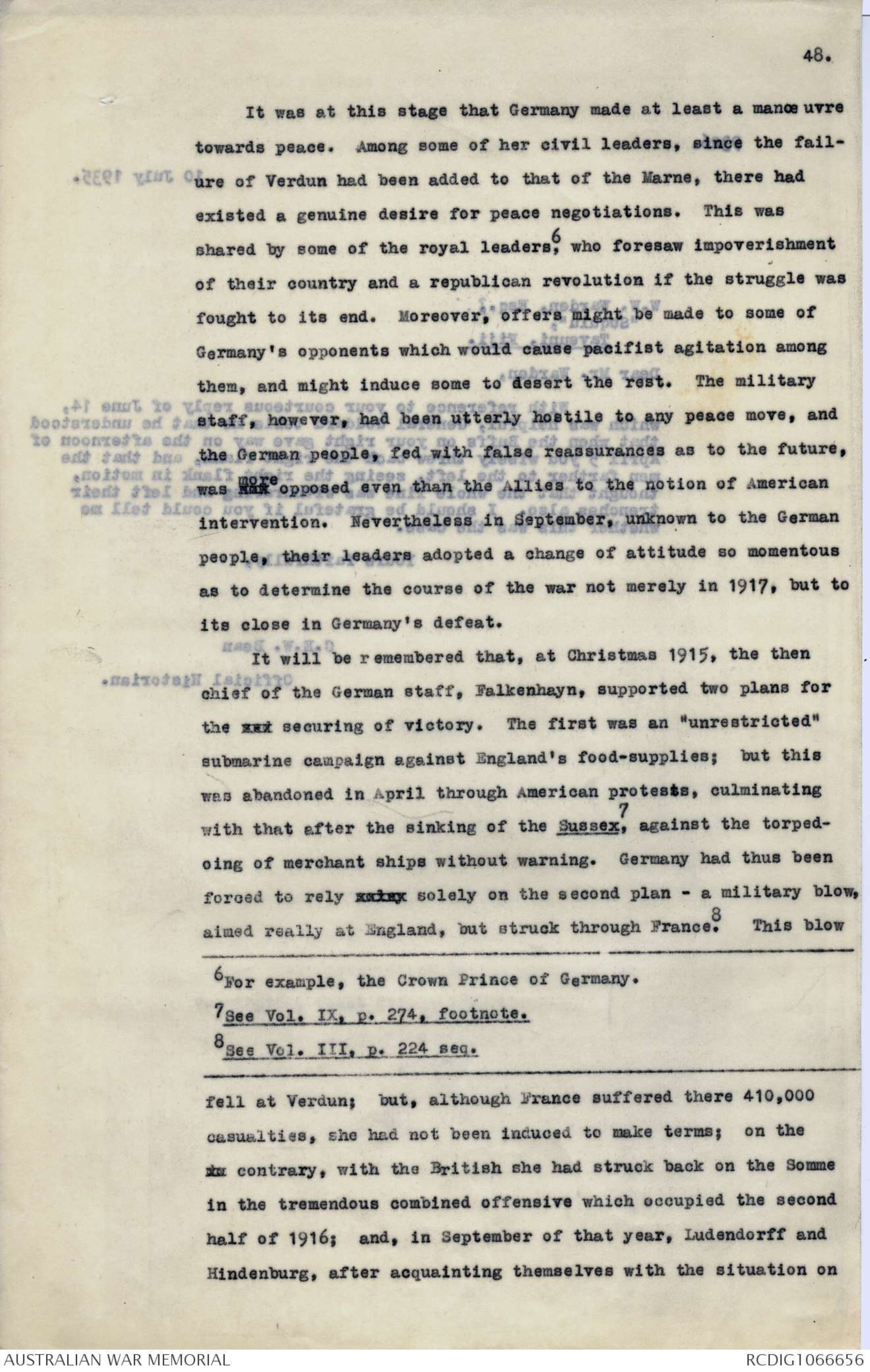
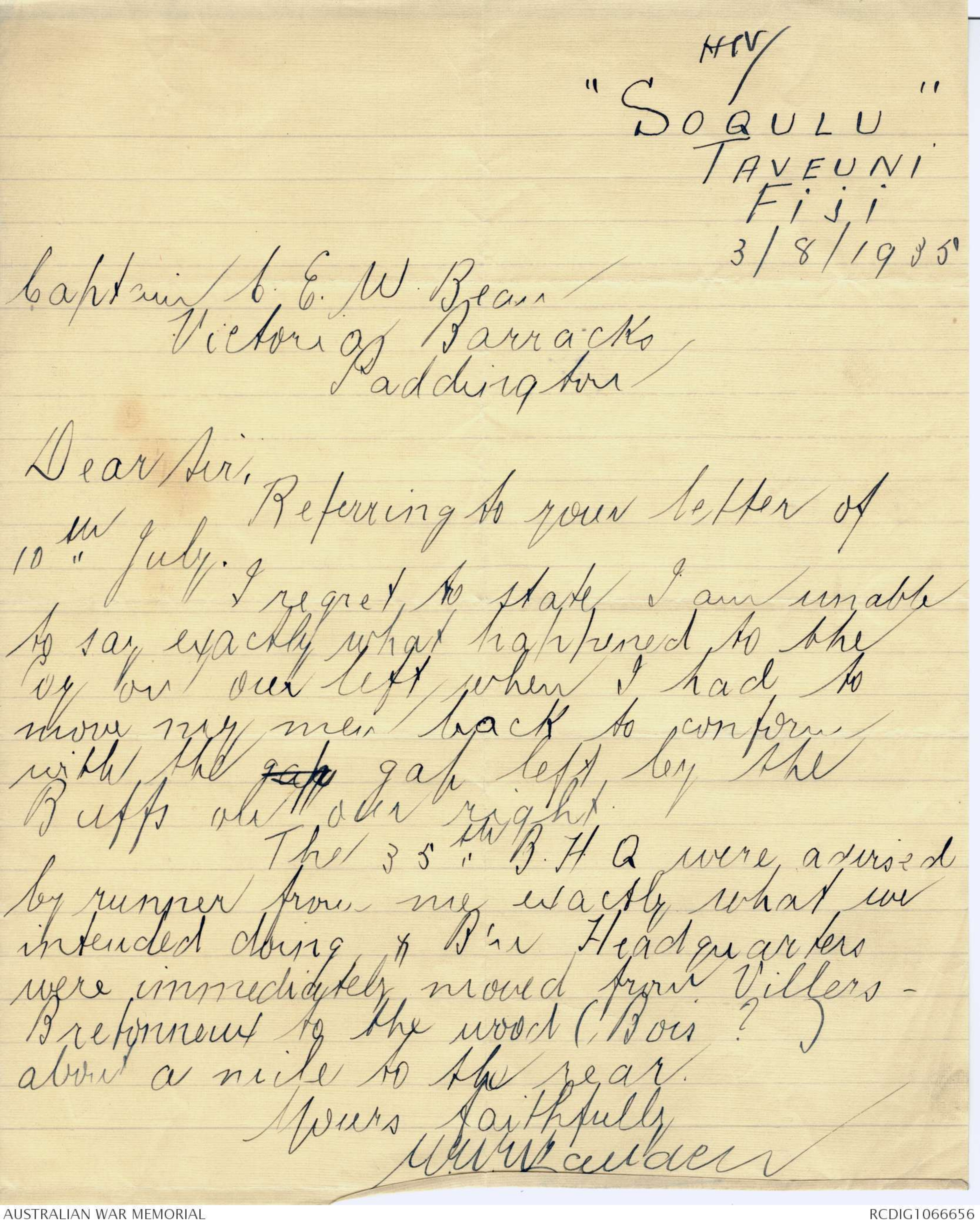
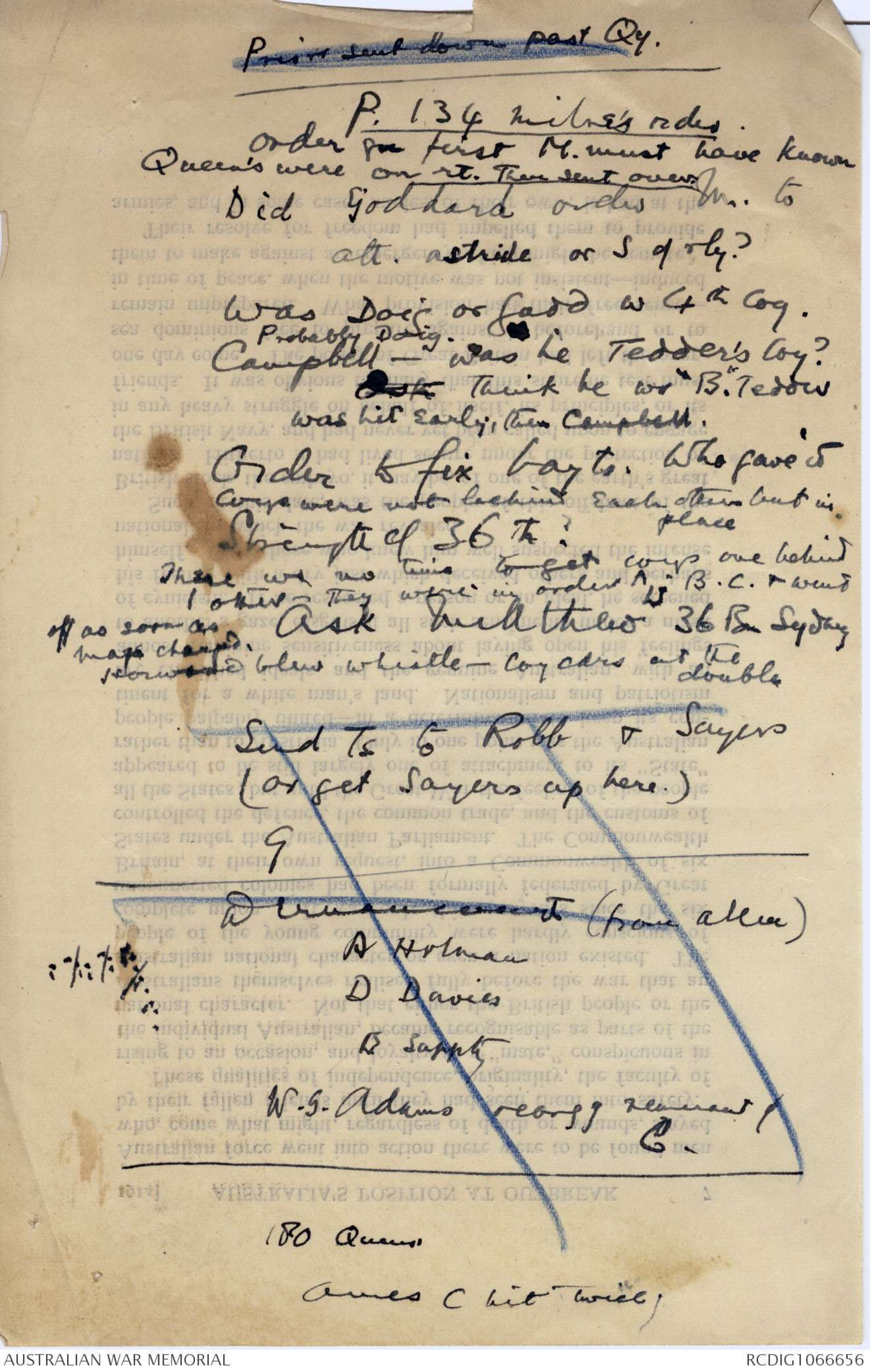
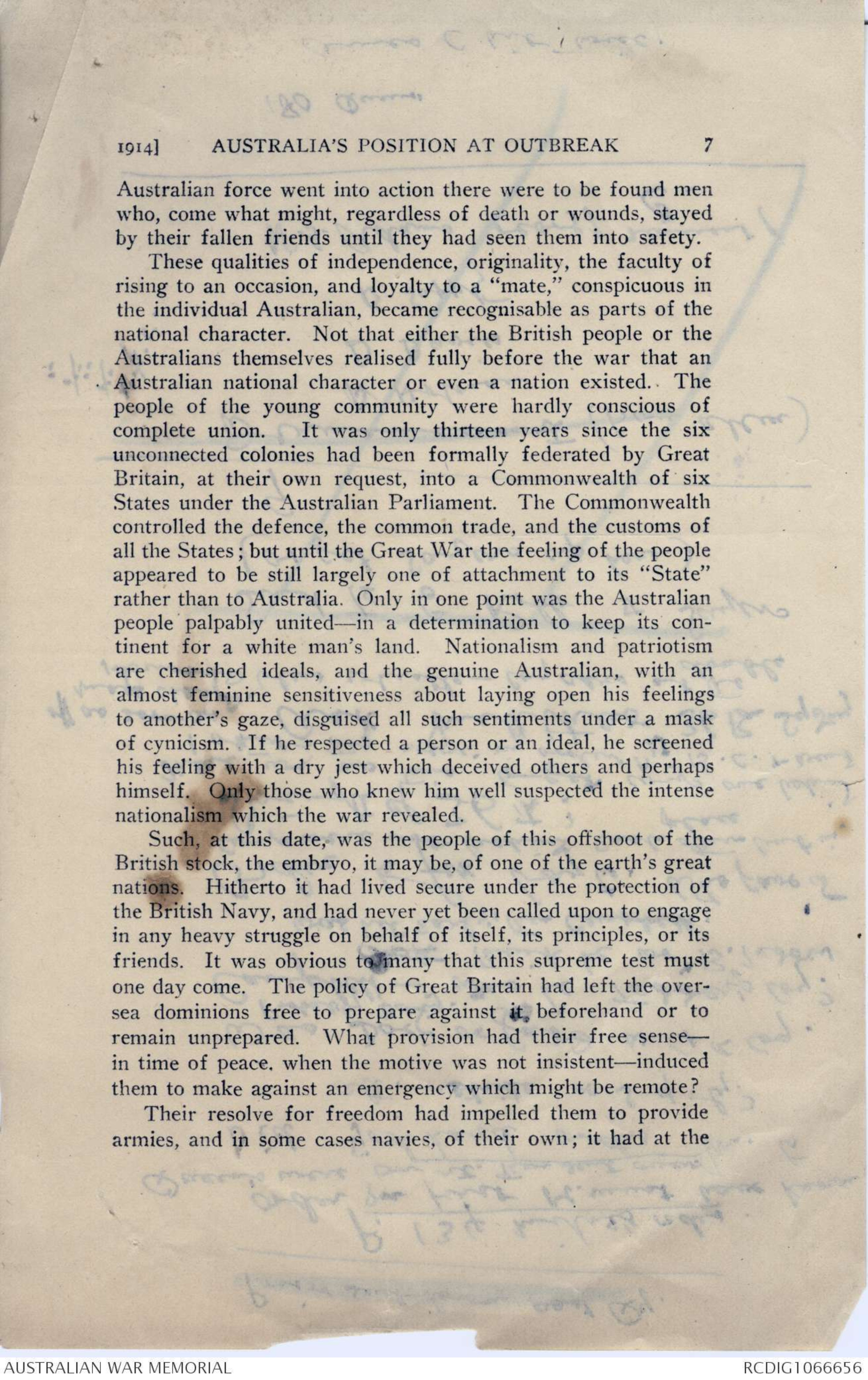
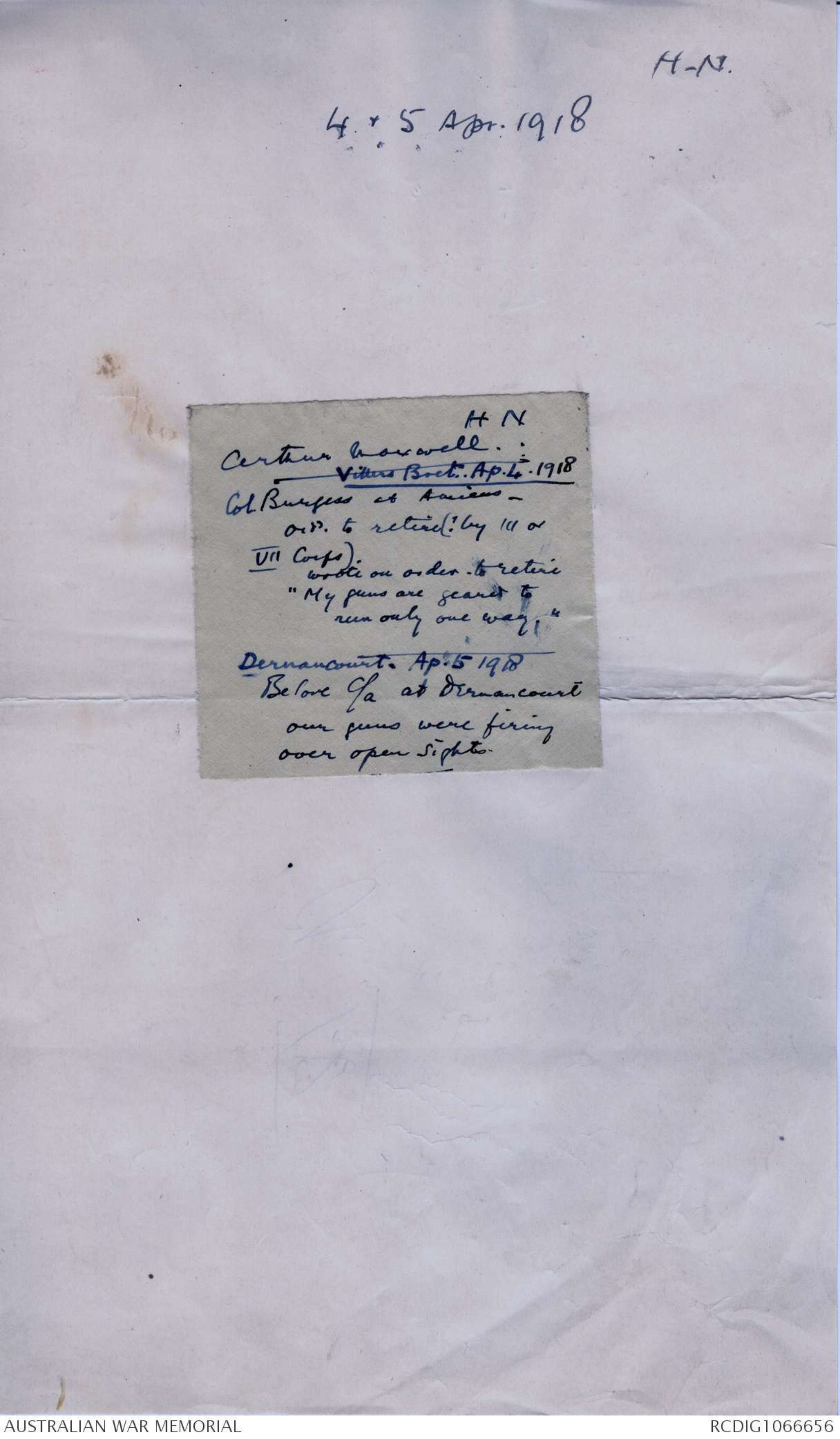
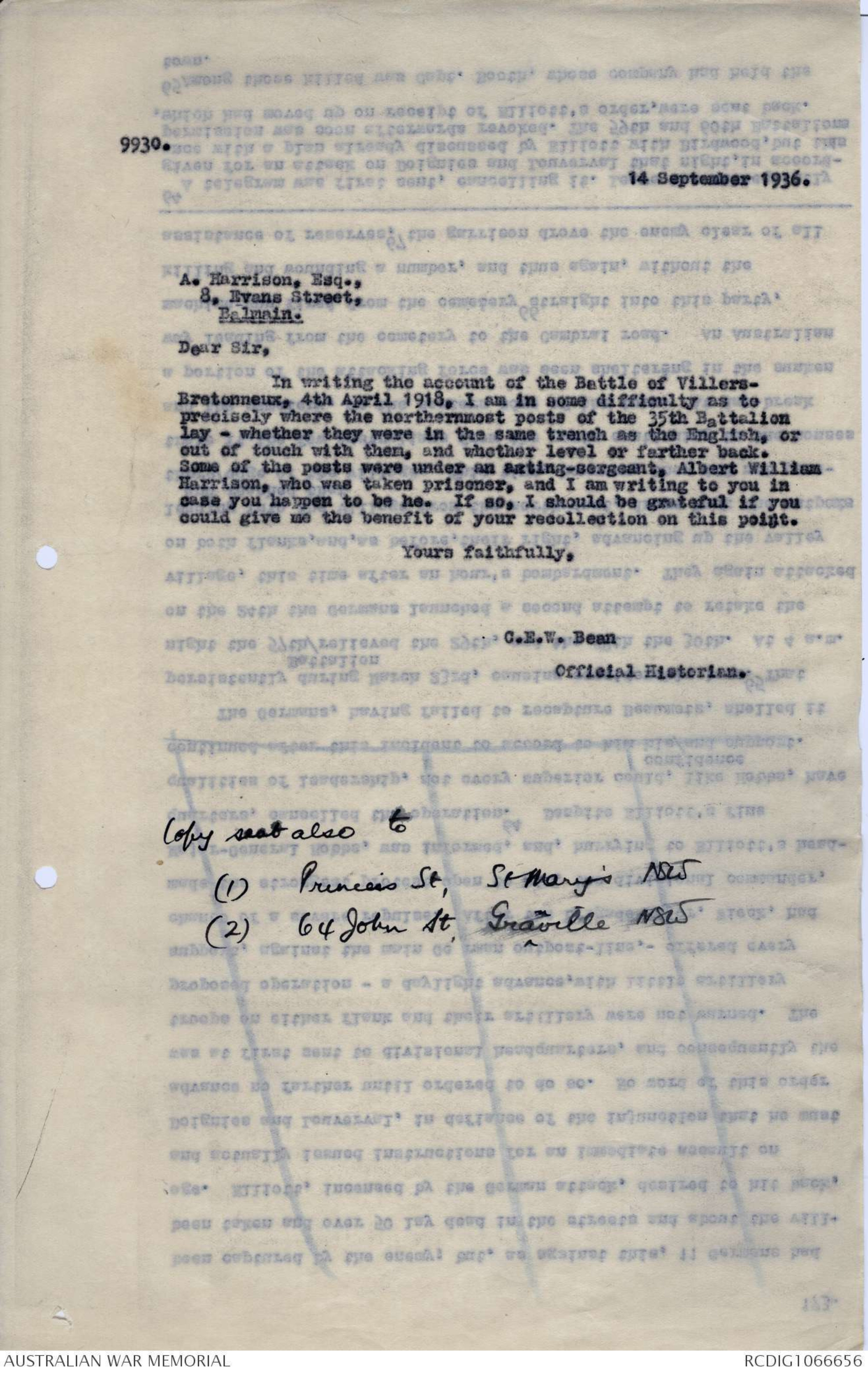
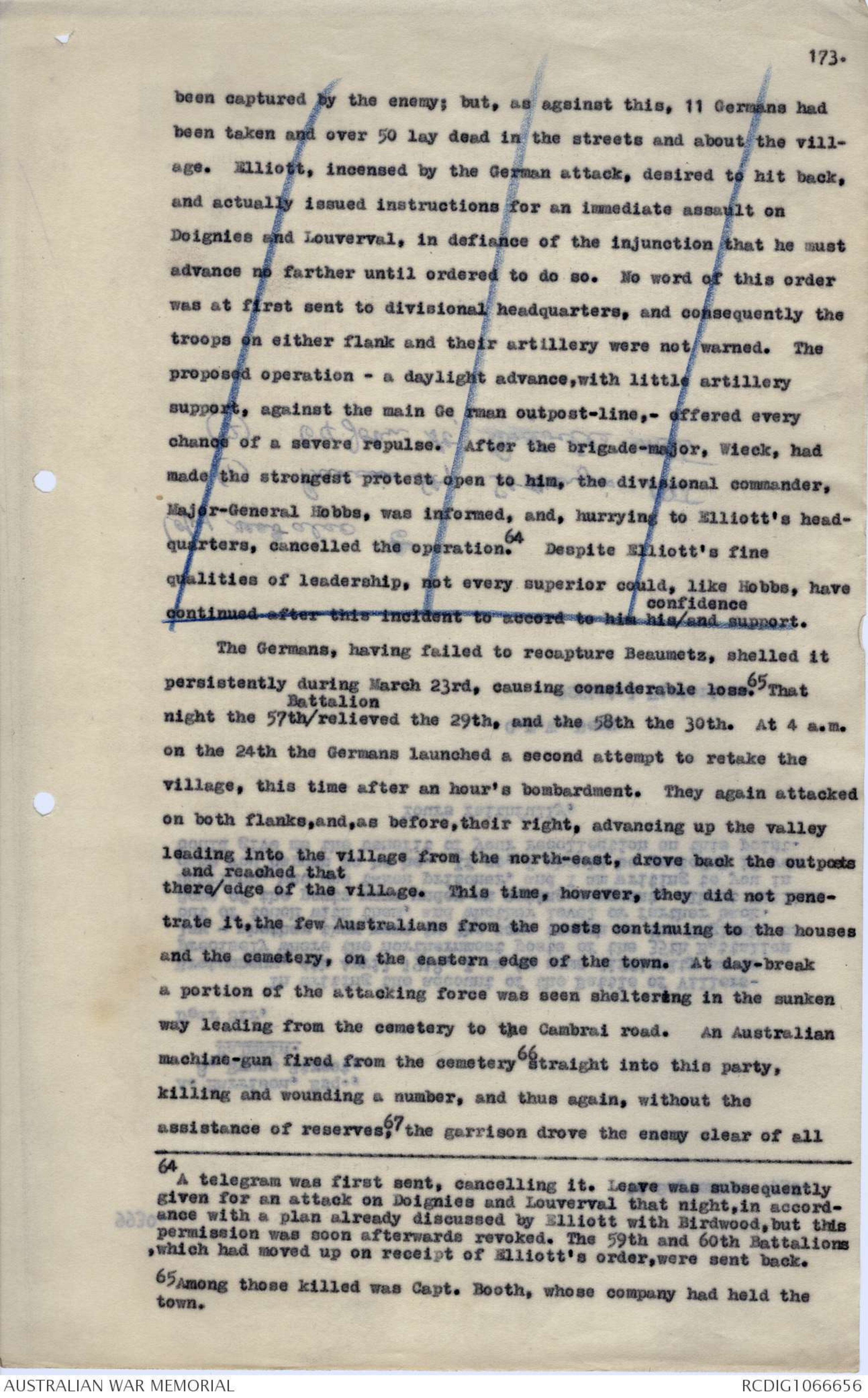
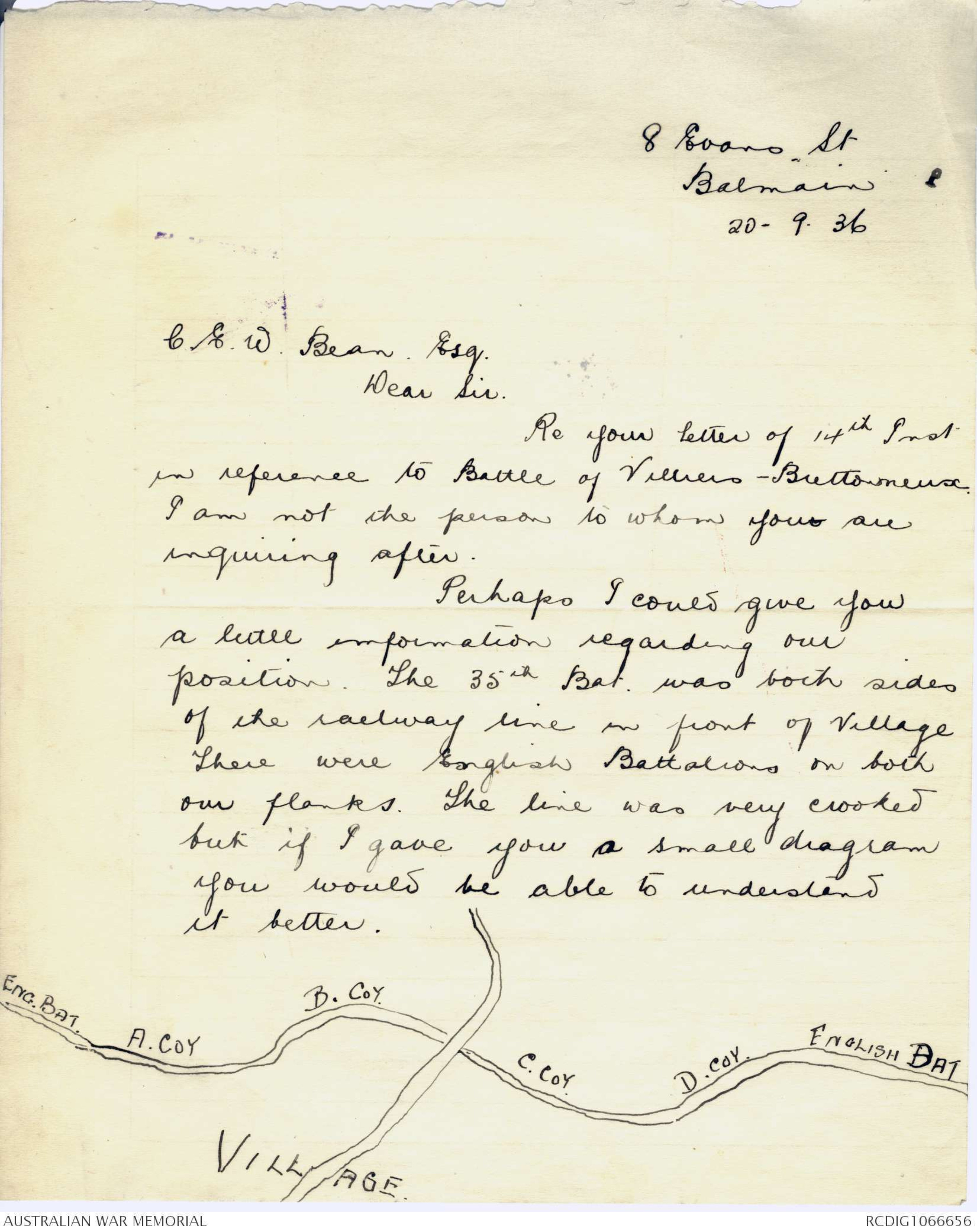
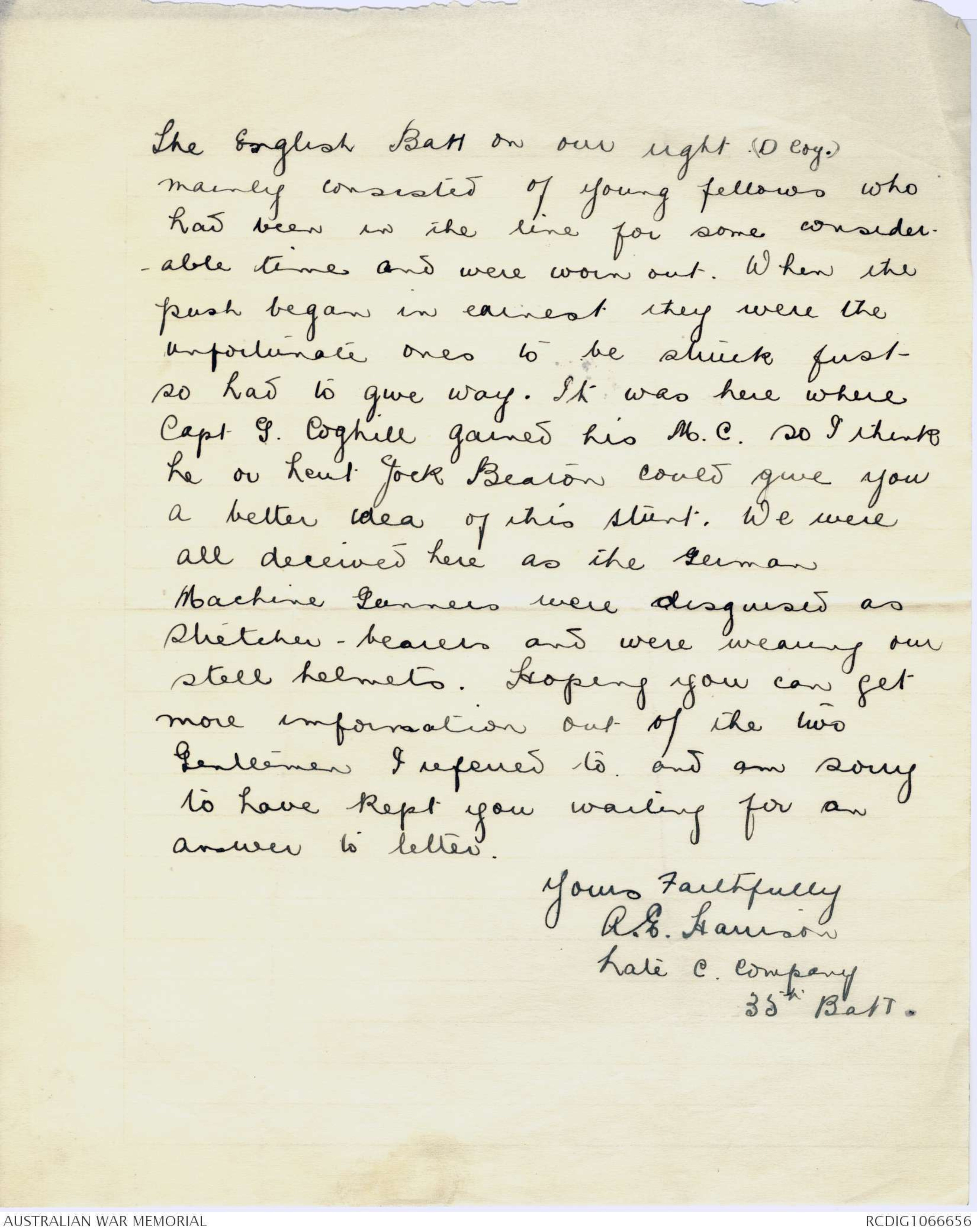
9326.
10 July 1935.
W.W. Warden, Esq.,
"Soqulu",
Taveuni, Fiji.
Dear Mr. Warden,
With reference to your courteous reply of June 14,
which was helpful, General Goddard tells me that he understood
that when the Buffs on your right gave way on the afternoon of
April 5 you wisely threw back the right flank, and that the
men farther to the left, seeing the right flank in motion,
thought that the whole line was withdrawing and left their
trenches also. I should be grateful if you could tell me
whether this was the case.
Yours faithfully,
C.E.W. Bean
Official Historian.
48
It was at this stage that Germany made at least a manœuvre
towards peace. Among some of her civil leaders, since the failure
of Verdun had been added to that of the Marne, there had
existed a genuine desire for peace negotiations. This was
shared by some of the royal leaders,6 who foresaw impoverishment
of their country and a republican revolution if the struggle was
fought to its end. Moreover, offers might be made to some of
Germany's opponents which would cause pacifist agitation among
them, and might induce some to desert the rest. The military
staff, however, had been utterly hostile to any peace move, and
the German people, fed with false reassurances as to the future,
was xxx more opposed even than the Allies to the notion of American
intervention. Nevertheless in September, unknown to the German
people, their leaders adopted a change of attitude so momentous
as to determine the course of the war not merely in 1917, but to
its close in Germany's defeat.
It will be remembered that, at Christmas 1915, the then
chief of the German staff, Falkenhayn, supported two plans for
the xxx securing of victory. The first was an "unrestricted"
submarine campaign against England’s food-supplies; but this
was abandoned in April through American protests, culminating
with that after the sinking of the Sussex,7 against the torpedoing
of merchant ships without warning. Germany had thus been
forced to rely xxxxx solely on the second plan - a military blow,
aimed really at England, but struck through France.8 This blow
————————————
6For example, the Crown Prince of Germany.
7See Vol. IX, p. 274, footnote.
8See Vol. III, p. 224 seq.
————————————
fell at Verdun; but, although France suffered there 410,000
casualties, she had not been induced to make terms; on thexx contrary, with the British she had struck back on the Somme
in the tremendous combined offensive which occupied the second
half of 1916; and, in September of that year, Ludendorff and
Hindenburg, after acquainting themselves with the situation on
[*HN/*]
"SOQULU"
TAVEUNI
Fiji
3/8/1935
Captain C.E.W. Bean
Victoria Barracks
Paddington
Dear Sir,
Referring to your letter of
10th July.
I regret to state I am unable
to say exactly what happened to the
Coy on our left when I had to
move my men back to conform
with the gap gap left by the
Buffs on our right.
The 35th B.H.Q. were advised
by runner from me exactly what we
intended doing & B'n Headquarters
were immediately moved from Villers-
Bretonneux to the wood (Bois ?)
about a mile to the rear.
Yours faithfully
W.W. Warden
Prisrs sent down past Qy.
P. 134 Milne's order.
Order gn first M. must have known
Queen's were on rt. Then sent over
Did Goddard order M. to
att. astride or S of rly?
Was Doig or Gadd w 4th Coy.
Probably Doig.
Campbell - was he Tedder's Coy?Ask Think he ws "B." Tedder
was hit early; then Campbell.
Order to fix bayts. Who gave it
Coys were not behind each other but in place
Strength of 36th?
There ws no time to get coys one behind
/ other - They were in order A. B. C. & went
off as soon as maps changed.
Ask Millthew Lt 36 Bn Sydney
Horward blew whistle - Coy cdrs at the
double
Send Ts to Robb & Sayers
(or get Sayers up here.)
9
Dernancourt (from Allen)
A. Holman
D Davies
B Sappty
W. G. Adams reorgg remnant of C.
180 [[Queens?]]
Ames (hit twice)
7
1914] AUSTRALIA'S POSITION AT OUTBREAK
Australian force went into action there were to be found men
who, come what might, regardless of death or wounds, stayed
by their fallen friends until they had seen them into safety.
These qualities of independence, originality, the faculty of
rising to an occasion, and loyalty to a "mate", conspicuous in
the individual Australian, became recognisable as parts of the
national character. Not that either the British people or the
Australians themselves realised fully before the war that an
Australian national character or even a nation existed. The
people of the young community were hardly conscious of
complete union. It was only thirteen years since the six
unconnected colonies had been formally federated by Great
Britain, at their own request, into a Commonwealth of six
States under the Australian Parliament. The Commonwealth
controlled the defence, the common trade, and the customs of
all the States; but until the Great War the feeling of the people
appeared to be still largely one of attachment to its "State"
rather than to Australia. Only in one point was the Australian
people palpably united—in a determination to keep its continent
for a white man's land. Nationalism and patriotism
are cherished ideals, and the genuine Australian, with an
almost feminine sensitiveness about laying open his feelings
to another's gaze, disguised all such sentiments under a mask
of cynicism. If he respected a person or an ideal, he screened
his feeling with a dry jest which deceived others and perhaps
himself. Only those who knew him well suspected the intense
nationalism which the war revealed.
Such, at this date, was the people of this offshoot of the
British stock, the embryo, it may be, of one of the earth's great
nations. Hitherto it had lived secure under the protection of
the British Navy, and had never yet been called upon to engage
in any heavy struggle on behalf of itself, its principles, or its
friends. It was obvious to many that this supreme test must
one day come. The policy of Great Britain had left the oversea
dominions free to prepare against it, beforehand or to
remain unprepared. What provision had their free sense—
in time of peace, when the motive was not insistent—induced
them to make against an emergency which might be remote?
Their resolve for freedom had impelled them to provide
armies, and in some cases navies, of their own; it had at the
[*H.N.
4 & 5 Apr. 1918*]
H N
Arthur Maxwell.
Villers Bret. Ap. 4. 1918
Col Burgess at Amiens -
ordd. to retire (:?by III
or VII Corps).
wrote on order to retire
"My guns are geared to
run only one way."
Dernancourt. Ap. 5 1918
Before C/a at Dernancourt
our guns were firing
over open sights.
9930.
14 September 1936.
A. Harrison, Esq.,
8, Evans Street,
Balmain.
Dear Sir,
In writing the account of the battle of Villers-
Bretonneux, 4th April 1918, I am in some difficulty as to
precisely where the northernmost posts of the 35th Battalion
lay - whether they were in the same trench as the English, or
out of touch with them, and whether level or farther back.
Some of the posts were under an acting-sergeant, Albert William
Harrison, who was taken prisoner, and I am writing to you in
case you happen to be he. If so, I should be grateful if you
could give me the benefit of your recollection on this point.
Yours faithfully.
C.E.W. Bean
Official Historian.
(* Copy sent also to
(1) Princess St, St Mary's NSW
(2) 64 John St, Gra∧nville NSW *)
173been captured by the enemy; but, as against this, 11 Germans hadbeen taken and over 50 lay dead in the streets and about the village.Elliott, incensed by the German attack, desired to hit back,and actually issued instructions for an immediate assault onDoignies and Louverval, in defiance of the injunction that he mustadvance no farther until ordered to do so. No word of this orderwas at first sent to divisional headquarters, and consequently thetroops on either flank and their artillery were not warned. Theproposed operation - a daylight advance, with little artillerysupport, against the main Ge rman outpost-line,- offered everychance of a severe repulse. After the brigade-major, Wieck, hadmade the strongest protest open to him, the divisional commander,Major-General Hobbs, was informed, and, hurrying to Elliott's headquarters,cancelled the operation.64 Despite Elliott's finequalities of leadership, not every superior could, like Hobbs, havecontinued after this incident to accord to him his ^confidence and support.
The Germans, having failed to recapture Beaumetz, shelled it
persistently during March 23rd, causing considerable loss.65 That
night the 57th /Battalion relieved the 29th, and the 58th the 30th. At 4 a.m.
on the 24th the Germans launched a second attempt to retake the
village, this time after an hour's bombardment. They again attacked
on both flanks, and, as before, their right, advancing up the valley
leading into the village from the north-east, drove back the outposts
there /and reached that edge of the village. This time, however, they did not
penetrate it, the few Australians from the posts continuing to the houses
and the cemetery, on the eastern edge of the town. At day-break
a portion of the attacking force was seen sheltering in the sunken
way leading from the cemetery to the Cambrai road. An Australian
machine-gun fired from the cemetery66 straight into this party,
killing and wounding a number, and thus again, without the
assistance of reserves,67 the garrison drove the enemy clear of all
————————————
64 A telegram was first sent, cancelling it. Leave was subsequently
given for an attack on Doignies and Louverval that night, in accordance
with a plan already discussed by Elliott with Birdwood, but this
permission was soon afterwards revoked. The 59th and 60th Battalions,
which had moved up on receipt of Elliott's order, were sent back.
65 Among those killed was Capt. Booth, whose company had held the
town.
8 Evans St
Balmain
20 - 9. 36
C.E.W. Bean. Esq.
Dear Sir.
Re your letter of 14th Inst.
in reference to Battle of Villiers-Brettonneux.
I am not the person to whom your are
inquiring after.
Perhaps I could give you
a little information regarding our
position. The 35th Bat. was both sides
of the railway line in front of Village
There were English Battalions on both
our flanks. The line was very crooked
but if I gave you a small diagram
you would be able to understand
it better.
Diagram - see original document
The English Batl on our right. (D Coy.)
mainly consisted of young fellows who
had been in the line for some considerable
time and were worn out. When the
push began in earnest they were the
unfortunate ones to be struck first -
so had to give way. It was here where
Capt G. Coghill gained his M.C. so I think
he or Lieut Jock Beaton could give you
a better idea of this stunt. We were
all deceived here as the German
Machine Gunners were disguised as
Stretcher-bearers and were wearing our
steel helmets. Hoping you can get
more information out of the two
gentlemen I referred to. and am sorry
to have kept you waiting for an
answer to letter.
Yours Faithfully
A.E. Harrison
Late C. company
35th Batt.
 Sam scott
Sam scottThis transcription item is now locked to you for editing. To release the lock either Save your changes or Cancel.
This lock will be automatically released after 60 minutes of inactivity.